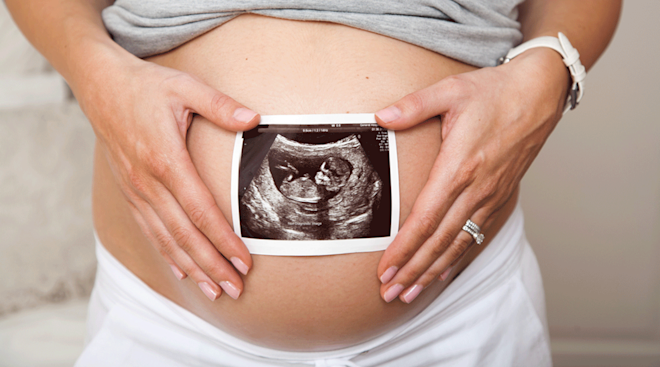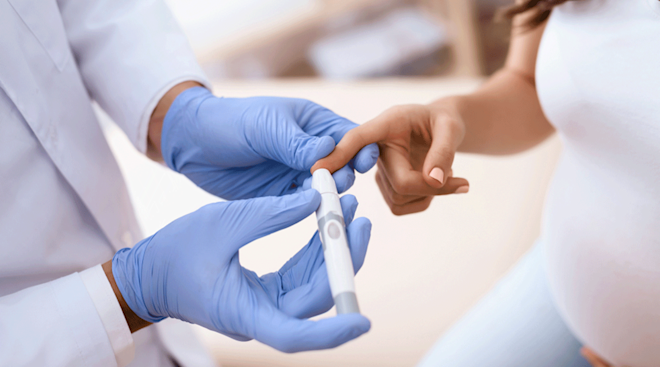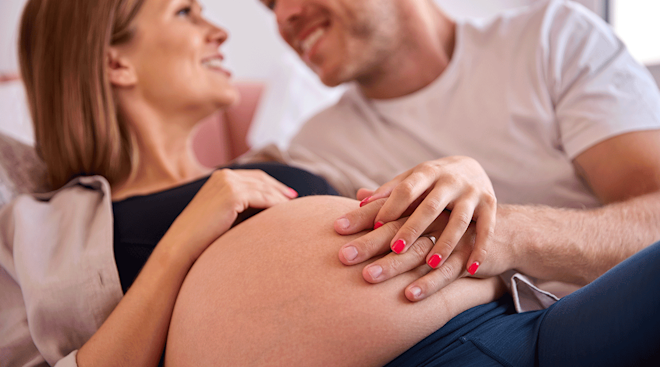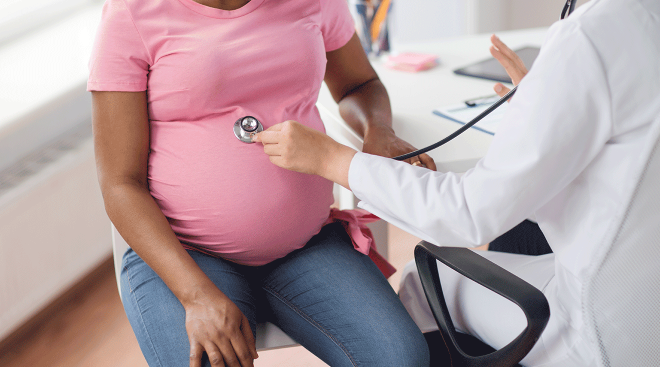What You Need to Know About Placenta Previa
No doubt you’re aware that the placenta plays an important role in your pregnancy. Among other things, the organ sends oxygen and nutrients to your growing baby and takes away waste. But sometimes, things can go wrong with the positioning of the placenta, a condition known as placenta previa—and that can have big implications for your pregnancy.
Along with the umbilical cord, the placenta is baby’s lifeline in the womb, so it’s normal to feel alarmed if your OB alerts you to a potential problem. And while placenta previa can be serious, proactive care and monitoring can help improve the outcome for you and baby. That said, you might still be wondering: What is placenta previa? How is it diagnosed? And what are typical placenta previa symptoms? We’re sharing all the important information you need to know.
In most pregnancies, the placenta attaches at the top or side of your uterus. But with placenta previa, the placenta partially or totally covers your cervix, says Jessica Shepherd, MD, an ob-gyn and director of minimally invasive gynecology at the University of Illinois College of Medicine in Chicago. But just because you receive a placenta previa diagnosis early in your pregnancy doesn’t mean you’ll have it as you get closer to giving birth. “It can occur early in pregnancy and resolve naturally,” says Los Angeles-based ob-gyn Pari Ghodsi, MD. “As the uterus grows, the placenta moves further away from the cervix.”
How common is placenta previa?
Placenta previa (sometimes referred to as low-lying placenta) occurs in the third trimester of about 1 out of every 200 pregnancies. “It’s not super common, but all obstetricians have seen it,” says Gerardo Bustillo, MD, an ob-gyn and director of minimally invasive surgery at Orange Coast Memorial Medical Center in Fountain Valley, California.
If you receive a placenta previa diagnosis during your first or second trimester, there’s a good chance it will fix itself by the third trimester, as the placenta can naturally move away from the cervix in the coming weeks and months. About 90 percent of the time the placenta will migrate to its rightful position by the time you’re ready to deliver—which is why some doctors may not even flag the issue if they notice it early in your pregnancy. However, if you still have it later on, they’ll work with you to make a plan for a healthy, safe delivery.
Possible placenta previa effects on baby
Placenta previa often causes bleeding during pregnancy, and if it’s severe enough, it can create health problems for you and baby. “Women can bleed from placenta previa at any time during pregnancy,” says Yvonne Bohn, MD, an ob-gyn at Providence Saint John’s Health Center in Santa Monica, California. If there is a lot of bleeding, baby may need to be delivered prematurely, she says. That can come with complications, such as problems with lung development, temperature regulation and breathing.
Also, if you go into labor with placenta previa, the placenta may tear. “That can be life-threatening to the woman and baby,” Bohn says. That’s why your doctor will monitor your condition throughout pregnancy, and if the placenta previa hasn’t resolved by the time you’re ready to deliver, your doctor may recommend a c-section.
Previa means “appearing in front of”—in this case, in front of the cervix. The terms used to describe the three different placenta previa types refer to the position of the placenta with respect to the cervix:
• Marginal previa happens when the placenta touches the edge of the cervix but doesn’t cover it.
• Partial previa describes the condition in which the placenta covers part, but not all, of the cervix.
• Complete previa, the most risky type of placenta previa, means that the placenta fully covers the entire opening of the cervix.
There are no known placenta previa causes, Bustillo says, but there are a few things that can raise your risk of having it:
• Previous c-section birth. Having had a prior c-section can increase your risk of placenta previa. Other surgeries that can result in scar tissue on the uterus, such as fibroid removal or dilation and curettage (D&C), can also up the odds.
• Having multiples. If you’re pregnant with twins or triplets (or more), you have a higher risk for the condition.
• Advanced maternal age. Women who are 35 or older when they give birth have an increased risk.
• Smoking in pregnancy. Research has linked the habit with placenta previa; this is likely because smoking narrows your blood vessels, limiting the supply of oxygen to the placenta.
• Cocaine use in pregnancy. A study found that cocaine use can increase the risk of placenta previa.
• In vitro fertilization. Research suggests that some reproductive fertility treatments may be associated with a higher rate of placenta previa.
How can I prevent placenta previa?
If you’re wondering how to prevent placenta previa, the unfortunate truth is that there’s no real way to avoid it. Fortunately, it’s not very common, but women who have certain predispositions may find themselves with a placenta previa diagnosis. Regular prenatal visits are your best bet to identify risk factors and receive appropriate care.
It’s possible to have placenta previa and not know it until your doctor spots it—but, typically, women will notice telltale placenta previa symptoms, Shepherd says. Signs of placenta previa include:
• Bleeding during pregnancy. Vaginal bleeding is a common symptom of placenta previa. It’s usually painless and is often bright red, ranging from light to heavy in flow. Significant bleeding typically indicates a more serious case of placenta previa.
• Early contractions. While not considered one of the main placenta previa symptoms, some women may experience them.
• Breech position. Though you probably won’t be able to feel this symptom, it’s worth noting that baby may move into a breech position—with their head up instead of down—if you have placenta previa. This may happen if the placenta is blocking the space where baby’s head would otherwise have more room.
Placenta previa can potentially lead to other issues, including premature birth, excessive bleeding and placenta accreta (when the placenta attaches deep into the uterine wall). The bleeding associated with this diagnosis can be particularly alarming because it can cause hemorrhaging, which can be life-threatening to Mom and baby, and may require a blood transfusion, an emergency c-section and possibly even a hysterectomy.
Furthermore, if you’re diagnosed with placenta previa, there’s a greater likelihood you’ll experience it again in subsequent pregnancies.
Placenta previa is typically diagnosed during a routine screening or after a woman has had vaginal bleeding during pregnancy, Shepherd says. In most cases, it’s confirmed at the second trimester ultrasound. Your doctor will likely order a follow-up ultrasound in the third trimester to see if the placenta has moved. In some instances, an MRI may be necessary.
Unfortunately, there’s no medication or procedure that can make placenta previa go away. Instead, doctors will typically monitor you closely via ultrasound to see if your condition changes. If you don’t have any bleeding or only little bleeding, Bohn says your doctor will typically recommend:
• No intense exercise
• No vaginal intercourse
• No vaginal exams of your cervix
Are there natural remedies for placenta previa?
Claims abound online promising magic fixes for placenta previa—from acupuncture to special herbal formulations. But the truth is, there’s no science to back any of that up. If you decide during your pregnancy to try any of these nonmedical placenta previa treatments, particularly holistic herbs, consult your doctor.
Is vaginal delivery possible with placenta previa?
While it may be possible to have a vaginal birth if your cervix is only partially covered, in most cases, a vaginal delivery isn’t recommended, says Ghodsi.
About 75 percent of women with placenta previa will have a scheduled c-section before they even go into labor. This is the most recommended route to prevent excessive and dangerous bleeding. Unstoppable bleeding may require an emergency c-section.
While there may be little you can do to avoid placenta previa, the good news is that a diagnosis can help you and your doctor create a plan of action. You’ll be monitored closely throughout pregnancy to ensure a safe delivery for you and baby.
About the experts:
Yvonne Bohn, MD, is an ob-gyn at Providence Saint John’s Health Center in Santa Monica, California. She received her medical degree at USC School of Medicine in Los Angeles, California.
Gerardo Bustillo, MD, is an ob-gyn and medical director of minimally invasive surgery at Orange Coast Medical Center in Fountain Valley, California. He earned his medical degree at Weill Medical College of Cornell University in New York City.
Pari Ghodsi, MD, is an ob-gyn at The San Fernando Valley at Northridge Hospital in Los Angeles, California. She received her medical degree from Baylor College of Medicine in Houston, Texas.
Jessica Shepherd, MD, is an ob-gyn and director of minimally invasive gynecology at the University of Illinois at Chicago. She received her medical degree from Ross University School of Medicine in St. Michael, Barbados.
Please note: The Bump and the materials and information it contains are not intended to, and do not constitute, medical or other health advice or diagnosis and should not be used as such. You should always consult with a qualified physician or health professional about your specific circumstances.
Plus, more from The Bump:
Navigate forward to interact with the calendar and select a date. Press the question mark key to get the keyboard shortcuts for changing dates.




















































